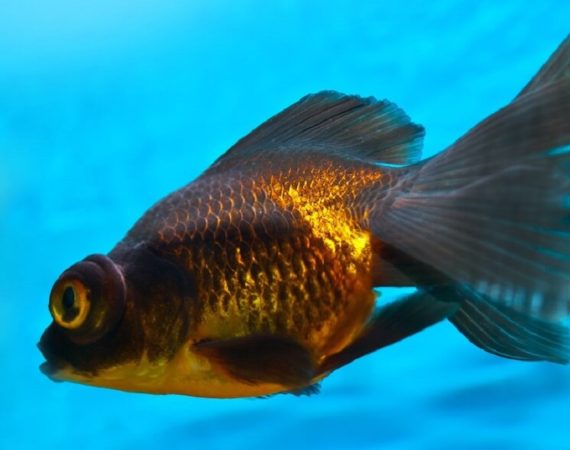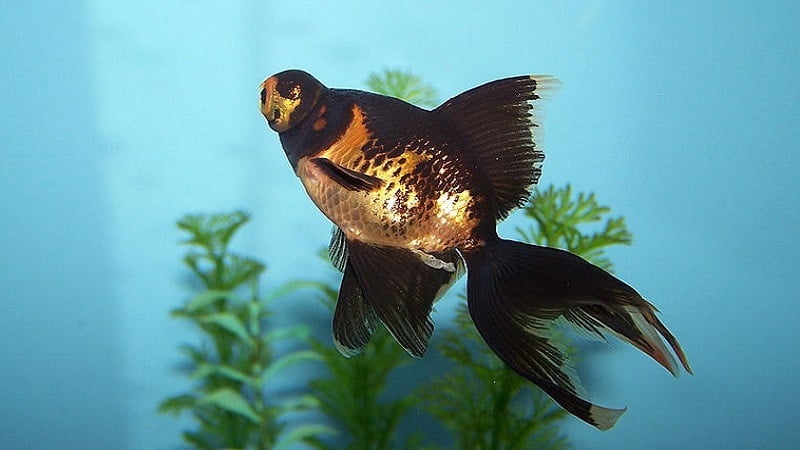When keeping a black goldfish for the first time, many people will be freaked out as they see their black goldfish turning to gold coloration. This is a common phenomenon, and in some cases, there is no need to worry too much about whether it affects your black goldfish’s health. Even though they have changed coloration, your fish may still be healthy.
Black goldfish can turn gold for a variety of reasons. In this article, I will show you 5 main reasons for black goldfish turning gold or orange and essential actions you can take to avoid this.
Related Articles
5 Main Reasons Why Black Goldfish Turning Gold
Part of the aging process
If you have black moors goldfish and they start turning gold, don’t worry too much. It may be because of the aging process. In other words, shifting from black to gold is a part of their aging process.
Actually, the black moor goldfish will retain their black coloration within the first year of their lives. Then, their coloration will change gradually to a more orange and gold scale. It is possible that black moorland might develop white spots before fading to gold or orange, making you think they have a disease.
The color of the black moor will change as they age, following this timeline:
- From 0 to 3 months: Silver
- From 3 months to 1 year: Black
- More than 1 year: slowly changing to gold or orange coloration scales.
Demelanization
Most goldfish initially develop brown or black coloration due to melanophores – biological pigment cells that allow color change – that determine in their dermal layer. Within a year of birth, they will go through a period of losing these black/brown pigments called demelanization. This is probably one of the demonstrations of black goldfish turning gold over time.
Accordingly, this is a natural occurrence for goldfish that have black coloration at the beginning. Demelanization is an essential process for goldfish to get their brighter and more desirable color scales, and it is not an indicator of health issues in your goldfish.
Velvet diseases
Velvet disease is caused by the Oodinium parasite that latches onto a fish’s skin, causing their skin to appear yellow. You can tell if your fish may be suffering from this disease by noticing that they seem to have coloration changing and be lethargic. The illness can be deadly if not treated.
Poor water quality
Poor water quality is another critical reason of your black goldfish turning gold, especially the black moors goldfish.
The poor water quality can result from the overfeeding action of the owner when they first buy a black goldfish. In addition, too much ammonia in the tank could have affected your black goldfish’s coloration and caused ammonia poisoning.
Water temperature
The tank temperature can also affect the coloration of your black goldfish (black moors). It is recommended that the tank temperature should be kept around 72°F (~ 22.2°C). When their tank temperature is too low or too high, you may notice that your black goldfish turn to gold or paler.
Insufficient Lighting
Your black goldfish will look pale when there is not enough light on their tank. Usually, you can notice this in the morning when you first open the tank. But after a while of leaving the light on, their original coloration should begin to return.

Possible Solutions To Avoid Black Goldfish Turning Gold
If the color fading of your goldfish is a natural occurrence or just a phase of the aging process, you can do nothing to solve this. This is normal and nothing to worry about.
If this is the result of environmental factors, including disease, water quality, temperature, and lighting, there are possible solutions for you to prevent this.
Fix the water quality
First thing, you should regularly check the water using a water tester kit to ensure the levels of ammonia, nitrates, nitrites, and pH are appropriate and neutral.
If you detect a high ammonia level in their tank, you should change the water more frequently. It is recommended to remove around 20-25% of the tank’s water and replace it with fresh, treated water.
You can preserve the water quality by checking the filter in the tank to ensure no blockage and dirt affect its performance. Then, you can clean it thoroughly.
Check and adjust the tank temperature
As mentioned, the tank temperature of around 72°F is ideal for your black goldfish and helps to limit the change of black goldfish turning gold.
So you should check the temperature and adjust it. If your black goldfish tank is near a window, you may want to move it to other places to prevent the direct sunlight from heating up the water. Also, consider moving the tank to another position with a more consistent temperature if you put it near heating equipment such as ovens. These kitchen appliances will cause a sudden increase in temperature toward the tank.
Provide black goldfish with enough light
The black pigment in your goldfish will likely disappear if they do not get enough light. In this case, you should place a light source in the tank and leave it on so that your black goldfish will get enough light. If you cannot set up a light in their tank, you can turn on lights in the room and leave it like that.
Treat the velvet disease
If you suspect your black goldfish is suffering from the velvet, you can take the following actions to treat it.
- Studies demonstrate that increasing temperature can accelerate the life cycle of parasites. Thus, you can try raising the water temperature to treat your infected black goldfish. The expected temperature of the tank is around 80°F (~27°C).
- Copper sulfate can be used to treat this disease. It is recommended to treat the affected fish for a period of ten days, following the manufacturer’s instructions, to completely eliminate the parasite.
- You can use other medications including Quinine salts, methylene blue, and Atabrine to treat the infestation.
- The effects of the Oodinium parasite will be more vivid and extreme under a strong light source. Thus, lowering the light brightness and keeping it dim for a couple of days can help reduce the infestation.
- During treatment, remove all carbon filtration from the tank because if you have velvet disease on your black goldfish, filters are counterproductive.
Video: My Black Goldfish Turning Gold
FAQs
Can black goldfish turn back to their original color?
nds on the cause. If the coloration change is caused by diseases or water quality, it is more likely that they can get their black coloration back.
Are black goldfish unhealthy?
A black streak or a small dot of dark color may develop on the fins of your goldfish, but this may be a result of genetics. You don’t have to worry too much as it is completely normal and does not result in any health problems.
How do I keep my black moor black?
Generally, you can help your black moors keep their rich black coloration by remaining the cooler water for their tank.
Conclusion
It is often normal when your black goldfish change their coloration to gold or orange as part of their aging process. At that time, you should keep an eye on your goldfish and don’t freak out.
However, if you notice that their black coloration becomes paler and starts to lose its brightness, your goldfish may have some problems. A lack of light, a lack of vitamins in their diet, poor water quality, or velvet disease may contribute to this color change in black goldfish.
Determining the cause and giving suitable solutions on time can help you limit this coloration change in your black goldfish. I hope that this article enables you to find out the reason of your black goldfish turning gold and essential actions to improve this situation.
References:

Annette M. Chaney is an experienced marine biologist with over 20 years of experience as an aquarist and fishkeeper. She started her first aquarium at a young age, filling it with frogs and goldfish obtained from the ten-cent pet store.
Annette grew up caring for and breeding African Cichlids, which led to a hobby in high school that doubled as a profitable means. Attending Reed College gave her time to solidify herself as an accomplished aquarium caretaker with an eye for sales. After that, from 2009 – 2013, she studied at Roger Williams University – one of the most prestigious universities for Aquaculture and Aquarium in USA. She is the founder of AquariumCircle since 2010.
